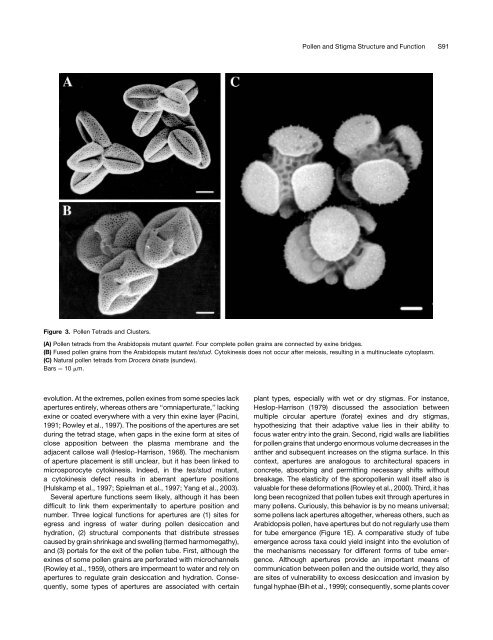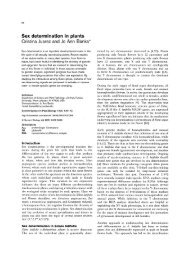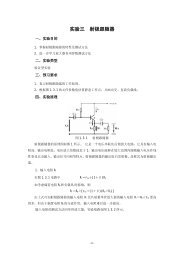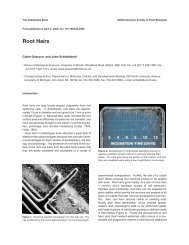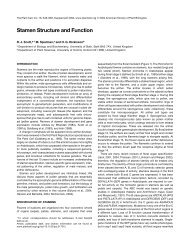Pollen and Stigma Structure and Function: The Role of Diversity in ...
Pollen and Stigma Structure and Function: The Role of Diversity in ...
Pollen and Stigma Structure and Function: The Role of Diversity in ...
You also want an ePaper? Increase the reach of your titles
YUMPU automatically turns print PDFs into web optimized ePapers that Google loves.
<strong>Pollen</strong> <strong>and</strong> <strong>Stigma</strong> <strong>Structure</strong> <strong>and</strong> <strong>Function</strong><br />
S91<br />
Figure 3. <strong>Pollen</strong> Tetrads <strong>and</strong> Clusters.<br />
(A) <strong>Pollen</strong> tetrads from the Arabidopsis mutant quartet. Four complete pollen gra<strong>in</strong>s are connected by ex<strong>in</strong>e bridges.<br />
(B) Fused pollen gra<strong>in</strong>s from the Arabidopsis mutant tes/stud. Cytok<strong>in</strong>esis does not occur after meiosis, result<strong>in</strong>g <strong>in</strong> a mult<strong>in</strong>ucleate cytoplasm.<br />
(C) Natural pollen tetrads from Drocera b<strong>in</strong>ata (sundew).<br />
Bars ¼ 10 mm.<br />
evolution. At the extremes, pollen ex<strong>in</strong>es from some species lack<br />
apertures entirely, whereas others are ‘‘omniaperturate,’’ lack<strong>in</strong>g<br />
ex<strong>in</strong>e or coated everywhere with a very th<strong>in</strong> ex<strong>in</strong>e layer (Pac<strong>in</strong>i,<br />
1991; Rowley et al., 1997). <strong>The</strong> positions <strong>of</strong> the apertures are set<br />
dur<strong>in</strong>g the tetrad stage, when gaps <strong>in</strong> the ex<strong>in</strong>e form at sites <strong>of</strong><br />
close apposition between the plasma membrane <strong>and</strong> the<br />
adjacent callose wall (Heslop-Harrison, 1968). <strong>The</strong> mechanism<br />
<strong>of</strong> aperture placement is still unclear, but it has been l<strong>in</strong>ked to<br />
microsporocyte cytok<strong>in</strong>esis. Indeed, <strong>in</strong> the tes/stud mutant,<br />
a cytok<strong>in</strong>esis defect results <strong>in</strong> aberrant aperture positions<br />
(Hulskamp et al., 1997; Spielman et al., 1997; Yang et al., 2003).<br />
Several aperture functions seem likely, although it has been<br />
difficult to l<strong>in</strong>k them experimentally to aperture position <strong>and</strong><br />
number. Three logical functions for apertures are (1) sites for<br />
egress <strong>and</strong> <strong>in</strong>gress <strong>of</strong> water dur<strong>in</strong>g pollen desiccation <strong>and</strong><br />
hydration, (2) structural components that distribute stresses<br />
caused by gra<strong>in</strong> shr<strong>in</strong>kage <strong>and</strong> swell<strong>in</strong>g (termed harmomegathy),<br />
<strong>and</strong> (3) portals for the exit <strong>of</strong> the pollen tube. First, although the<br />
ex<strong>in</strong>es <strong>of</strong> some pollen gra<strong>in</strong>s are perforated with microchannels<br />
(Rowley et al., 1959), others are impermeant to water <strong>and</strong> rely on<br />
apertures to regulate gra<strong>in</strong> desiccation <strong>and</strong> hydration. Consequently,<br />
some types <strong>of</strong> apertures are associated with certa<strong>in</strong><br />
plant types, especially with wet or dry stigmas. For <strong>in</strong>stance,<br />
Heslop-Harrison (1979) discussed the association between<br />
multiple circular aperture (forate) ex<strong>in</strong>es <strong>and</strong> dry stigmas,<br />
hypothesiz<strong>in</strong>g that their adaptive value lies <strong>in</strong> their ability to<br />
focus water entry <strong>in</strong>to the gra<strong>in</strong>. Second, rigid walls are liabilities<br />
for pollen gra<strong>in</strong>s that undergo enormous volume decreases <strong>in</strong> the<br />
anther <strong>and</strong> subsequent <strong>in</strong>creases on the stigma surface. In this<br />
context, apertures are analogous to architectural spacers <strong>in</strong><br />
concrete, absorb<strong>in</strong>g <strong>and</strong> permitt<strong>in</strong>g necessary shifts without<br />
breakage. <strong>The</strong> elasticity <strong>of</strong> the sporopollen<strong>in</strong> wall itself also is<br />
valuable for these deformations (Rowley et al., 2000). Third, it has<br />
long been recognized that pollen tubes exit through apertures <strong>in</strong><br />
many pollens. Curiously, this behavior is by no means universal;<br />
some pollens lack apertures altogether, whereas others, such as<br />
Arabidopsis pollen, have apertures but do not regularly use them<br />
for tube emergence (Figure 1E). A comparative study <strong>of</strong> tube<br />
emergence across taxa could yield <strong>in</strong>sight <strong>in</strong>to the evolution <strong>of</strong><br />
the mechanisms necessary for different forms <strong>of</strong> tube emergence.<br />
Although apertures provide an important means <strong>of</strong><br />
communication between pollen <strong>and</strong> the outside world, they also<br />
are sites <strong>of</strong> vulnerability to excess desiccation <strong>and</strong> <strong>in</strong>vasion by<br />
fungal hyphae (Bih et al., 1999); consequently, some plants cover


